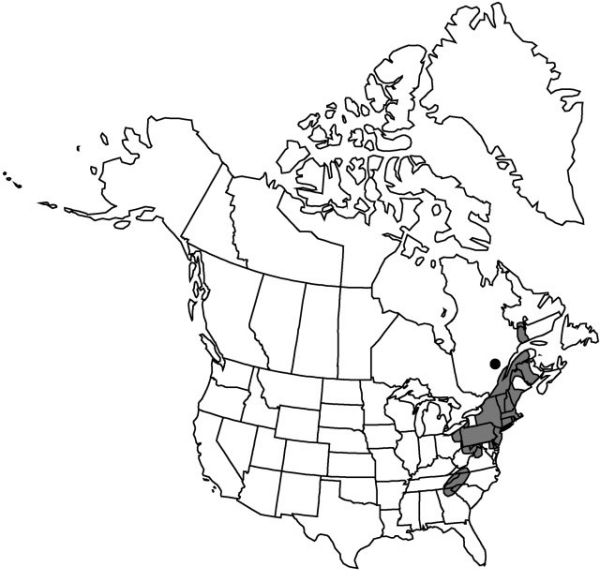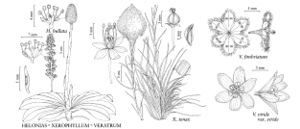Difference between revisions of "Veratrum viride var. viride"
FNA>Volume Importer |
imported>Volume Importer |
||
| (6 intermediate revisions by 2 users not shown) | |||
| Line 1: | Line 1: | ||
{{Treatment/ID | {{Treatment/ID | ||
|accepted_name=Veratrum viride var. viride | |accepted_name=Veratrum viride var. viride | ||
| − | |accepted_authority= | + | |accepted_authority= |
|publications= | |publications= | ||
|basionyms= | |basionyms= | ||
| Line 19: | Line 19: | ||
|elevation=0–1600 m | |elevation=0–1600 m | ||
|distribution=N.B.;Nfld. and Labr.;Que.;Conn.;Del.;Ga.;Maine;Md.;Mass.;N.H.;N.J.;N.Y.;N.C.;Ohio;Pa.;R.I.;S.C.;Tenn.;Vt.;Va.;W.Va. | |distribution=N.B.;Nfld. and Labr.;Que.;Conn.;Del.;Ga.;Maine;Md.;Mass.;N.H.;N.J.;N.Y.;N.C.;Ohio;Pa.;R.I.;S.C.;Tenn.;Vt.;Va.;W.Va. | ||
| − | |discussion=<p>Eastern Native Americans (Cherokee and Iroquois) used Veratrum viride var. viride as an antirheumatic and analgesic as well as a cold, skin, and orthopedic aid (D. E. Moerman 1986). Colonial settlers soaked corn seeds in an infusion of the plant to kill marauding birds (J. U. Lloyd 1897). This variety is considered a pasture weed in areas around Quebec and in the New England states (C. A. Taylor 1956).</p> | + | |discussion=<p>Eastern Native Americans (Cherokee and Iroquois) used <i>Veratrum viride </i>var.<i> viride</i> as an antirheumatic and analgesic as well as a cold, skin, and orthopedic aid (D. E. Moerman 1986). Colonial settlers soaked corn seeds in an infusion of the plant to kill marauding birds (J. U. Lloyd 1897). This variety is considered a pasture weed in areas around Quebec and in the New England states (C. A. Taylor 1956).</p> |
|tables= | |tables= | ||
|references= | |references= | ||
| Line 28: | Line 28: | ||
-->{{#Taxon: | -->{{#Taxon: | ||
name=Veratrum viride var. viride | name=Veratrum viride var. viride | ||
| − | + | |authority= | |
| − | |authority= | ||
|rank=variety | |rank=variety | ||
|parent rank=species | |parent rank=species | ||
| Line 43: | Line 42: | ||
|publication year= | |publication year= | ||
|special status= | |special status= | ||
| − | |source xml=https:// | + | |source xml=https://bitbucket.org/aafc-mbb/fna-data-curation/src/2e0870ddd59836b60bcf96646a41e87ea5a5943a/coarse_grained_fna_xml/V26/V26_57.xml |
|genus=Veratrum | |genus=Veratrum | ||
|species=Veratrum viride | |species=Veratrum viride | ||
Latest revision as of 22:15, 5 November 2020
Stems glabrous proximally, ± tomentose distally. Leaves 15–25 × 10–18 cm. Inflorescences with branches ascending to spreading, only rarely drooping. Flowers spreading to rarely erect; tepals deep green, 6–10 mm. 2n = 32.
Phenology: Flowering early summer–fall.
Habitat: Moist clearings, shaded woodlands
Elevation: 0–1600 m
Distribution

N.B., Nfld. and Labr., Que., Conn., Del., Ga., Maine, Md., Mass., N.H., N.J., N.Y., N.C., Ohio, Pa., R.I., S.C., Tenn., Vt., Va., W.Va.
Discussion
Eastern Native Americans (Cherokee and Iroquois) used Veratrum viride var. viride as an antirheumatic and analgesic as well as a cold, skin, and orthopedic aid (D. E. Moerman 1986). Colonial settlers soaked corn seeds in an infusion of the plant to kill marauding birds (J. U. Lloyd 1897). This variety is considered a pasture weed in areas around Quebec and in the New England states (C. A. Taylor 1956).
Selected References
None.
